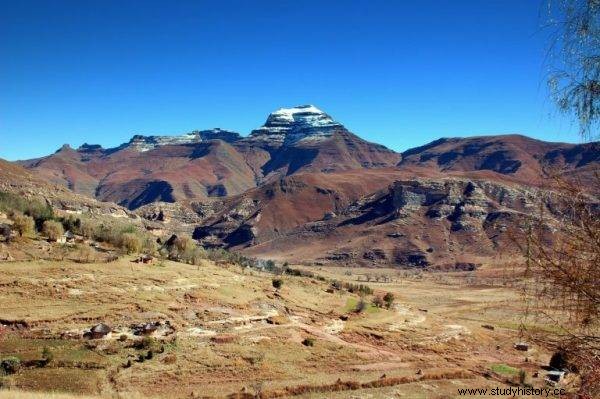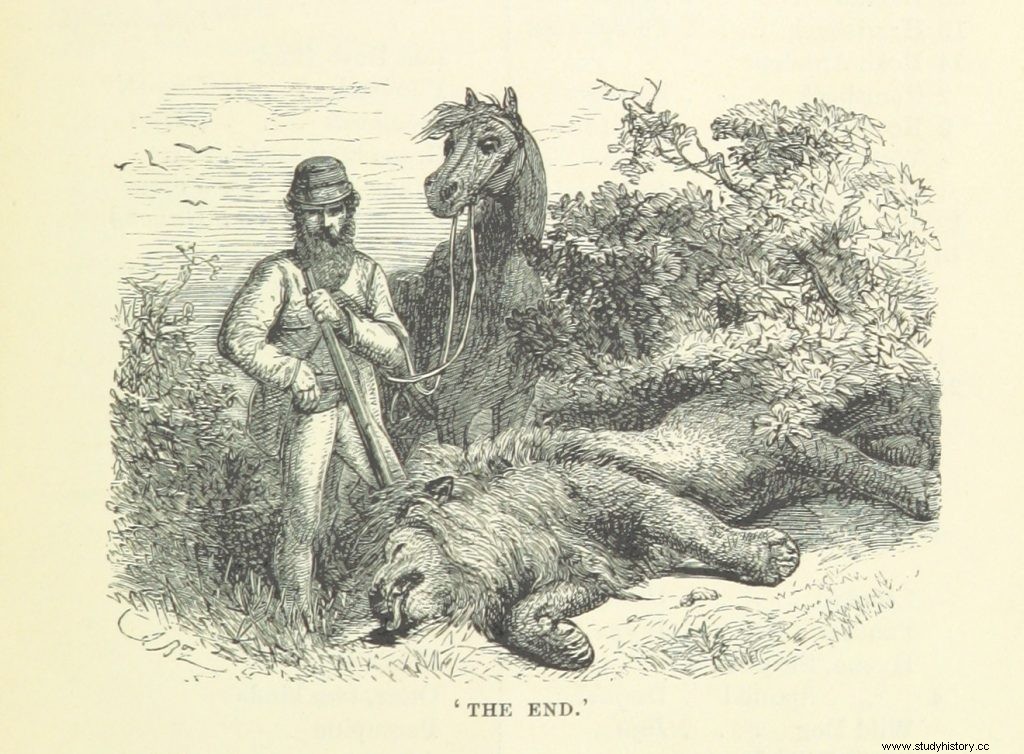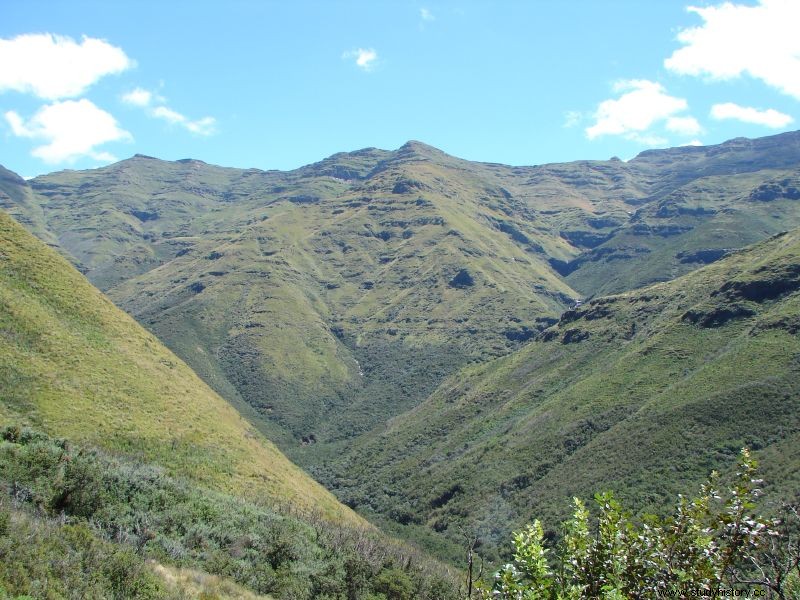Human impact on the natural environment is now referred to as anthropopressure. It has a direct impact on the local flora and fauna. It includes both accidental and deliberate actions to transform and adapt the environment to human needs.
In order to trace the process of animal extinction in Lesotho and identify the most important factors decimating fauna in southern Africa, researchers studied three categories of sources. These include the results of archaeological research, historical accounts of British colonizers, and oral accounts of Lesotho residents from the 1930s to the present day.
Geography of Lesotho
Lesotho is a small country located in South Africa. It is an independent enclave surrounded by South Africa. Despite the small area (30,300 km2), the topography of this country is very diverse . The western part of Lesotho is characterized by wide plains, intersected in places by hills. However, the vast majority of the country is made up of the highlands and mountain ranges of Maloti, Thaba Putsoa, the Central Range and the Drakensberg Mountains. The main river of the state is Oranje, but the border Caledon River is the main source of drinking water for Lesotho. The lowland region is characterized by vegetation typical of the savannah, defined by a collective Afrikaans term sourveld . In mountainous regions there is vegetation described as Afro-Alpine.
Anthropopression and Anthropocene
Anthropopression is all human activities influencing the environment in order to transform it into human needs. In extreme cases, there is degradation of the natural environment, deforestation or destruction of animal habitats. Human activity also inevitably leads to soil and water pollution, as well as climate change and gradual desertification. In the case of southern Africa, the anthropogenic factors leading to a decrease in the population of wild fauna can also include the deliberate extermination of animals (especially predators and animals considered to be pests) or industrial poaching bushmeat .

The foothill landscape and the Maloti mountain range in northern Lesotho © christopher charles
published under license CC BY-NC-SA 2.0, via Wikimedia Commons
In reflection on the influence of man on the natural environment, some researchers propose to distinguish the latest geological epoch referred to as the Anthropocene . While the dating of the beginning of this era is still under discussion, the most important features of this period have already been determined at the beginning of the 21st century. These include the reduction of biodiversity, dynamic deforestation and urbanization, environmental pollution and the exploitation of fossil fuels.
Archeology
Information on the occurrence of individual species of mammals since the end of the Pleistocene was obtained from the numerous results of excavations at archaeological sites (both cave and open) in Lesotho. The main criterion was the presence of animal remains in human settlements. However, as noted, this information is limited, for example, by the food preferences of ancient hunters from the area. The lack of animal remains at archaeological sites does not mean that they did not exist in the area in the past. There are even two reasons for this. First, a cultural, religious, or ritual taboo might have prohibited hunting of certain species. Second, their meat didn't just have to be tasty.
During the maximum period of the last glaciation, around 21,000 years ago, the climate was clearly cooler than in the following periods, which was followed by a low biodiversity of the fauna. The representatives of the Pleistocene megafauna were dominated by bison, great buffalos, or the then living great zebra ( Equus capensis ). These species became extinct during natural climate change at the beginning of the Holocene, about 11,000 / 10,000 years ago. After these events, one of the most numerous species of large mammals was the extinct antelope (Bond's springbok), which became extinct about 7,500 years ago as a result of successive climate changes associated with sudden cooling and desertification in southern Africa. Species such as the great kudu, savannah catfish, griffon gray, common antelope, roe deer pele and rock goat were recorded mainly at sites in the mountainous regions of Lesotho, and already from about 10,000-8,000 years ago these species also began to appear in lowland areas. The Middle and Late Holocene is characterized by alternating wet-warm and dry-cold episodes. Researchers recognize that they led to the natural spread of individual species in mountain or lowland areas observed to the present day.
In this period, species such as the scrub wild boar, steppe zebra, bear baboon, rock hyrax, pale deer, mountain ridbok, rock goat, wildebeest, red buffalo, sasebi Zulu, antelope jump, black-backed jackal, steppe caracal or Nubian cat were particularly common. . The leopard is dominant among large felids. However, during this period, the remains of a lion and a cheetah are very rarely observed. Similarly, spotted hyenas or brown hyenas were rare, appearing in much greater numbers about 3,000 years ago.
Another very important source is rock art . The detail of the depictions of animals rarely allows the species of the animal to be precisely defined, but at least the family can be defined. Depictions of impala are especially common on panels in a lowland area. In the area of the highlands, mecaceae, pangolins and maned proteles were often shown. Rock art therefore allowed researchers to expand the list of species occurring in these periods.

Presentation of the common eland on a panel in the Drakensberg Mountains associated with the ancestors of the San people © Lukas Kaffer published under license CC BY-SA 3.0, via Wikimedia Commons
Interestingly, the results of the research allowed to observe a clear trend in increasing biodiversity . Between 14,000 and 10,000 years ago, there were at least 29 species of animals in this area. In the period between 10,000 and 5,000 years ago, about 31 species. Between 5,000 and 3,000 years ago, about 36 species of animals. During the last 3,000 years, Lesotho has been inhabited by at least 43 species of mammals. This trend may be related both to the increase in the number of archaeological sites in particular periods, but also to natural climatic changes, which contributed to the increase in biodiversity.
Historical Colonial Relationships
descriptions are much more reliable morals compiled by European explorers and colonizers. The first Europeans did not hide their fascination with the exotic and numerous wild fauna of South Africa and described the animals they observed in full of passionate accounts. Knowledge was drawn from archives in Great Britain and Lesotho. The analyzed descriptions were written between 1830 and 1900. The most active authors were Thomas Arbousset and Eugène Casali of the Evangelical Missionary Society in Paris, and British colonial administrators such as Dr. Andrew Smith and Sir Godfrey Lagden. Another important source was the local Sotho-language newspaper Leselinyana la Lesotho. The first edition of the biweekly magazine was published in 1863. There are also limitations in this category of sources. Descriptions of Europeans are limited to the areas surrounding their residences and the areas where they have moved. The 'charisma' of the animal species is also important. The majestic lion will be much more often mentioned than the less spectacular, rare, secretive, or shy species of animal. Nocturnal species will also be described less frequently.

An image from African Hunting from Natal to the Zambesi including Lake Ngami, the Kalahari Desert, andc. from 1852 to 1860 by William Charles Baldwin. Courtesy of the British Library. Published under the Public Domain Mark 1.0
licenseResearchers also noted toponyms . In the Lesotho region, many villages and geographies refer to specific animal species in their names. This indicates both the presence of a specific animal in the area, as well as its cultural, symbolic or religious significance for local communities. This is not limited to the territory of modern Lesotho. The adjacent area of the Mangaung metropolitan area of South Africa marks the place of the cheetah in Sotho.
In the 1830s, French missionaries drew attention to great variety and numbers herds of wild animals. The most frequently mentioned wildebeest, steppe zebras, antelope jumpers and red buffalo inhabiting the plains by the Caledon River. Equally numerous predators such as lions and hyenas also caused many problems, which, according to archaeological data, were found in southern Africa before around 3000 BC. occured sporadically. Predators could also attract livestock. On July 22, 1833, Eugène Casali wrote in his account:
Wild animals had been troubling us all the night before…. Dozens of terrifying lions swarmed along the banks of the Caledon River. They ate one of my oxen.
Herbivorous animals also ravaged fields and vegetable gardens. Some of the breeding cows and steers also departed with the herds of brown wildebeest deep into the savannah.
One of the first reports showing a decline in stocks wild animals dates from 1840. Thomas Arbousset, while hunting in the Maloti Mountains, argued that the eland herds had declined significantly in recent years. It was one of the most popular large mammals that Europeans hunted for entertainment. Until 1846, these animals were found only in inaccessible upland and mountain regions. The riverside plains during this period still provided favorable habitats for many animal species. Europeans paid particular attention to the huge herds of quagga zebra, red buffalo, brown wildebeest and antelope jumpers.

Steppe zebras and brown wildebeest. Mammalian species co-occurring in the Lowlands of Lesotho probably since the Middle Holocene © Mosi Lager published under license CC BY-NC-SA 2.0, via Wikimedia Commons
A very good example of early anthropopressure is cutting down riverside acacia forests in order to convert these areas into pastures. Significant areas along the Caledon River were thus transformed by 1856. As a result, species such as lions, wildebeest, hyenas, quagga zebras and antelope jumpers have almost completely disappeared from the area. In their place, the Europeans brought in large herds of sheep, mules, goats, cows, horses and oxen. This situation is best illustrated in the account of the missionary Prosper Lemue of October 28, 1861:
Back in the spring [to Lesotho] my wife and I went to the plains called jagt veld, or hunting grounds. What a silence! What a void! There are no gazelles, no roaring lions, no more jackals to break the monotony of the desert.
Biodiversity gradually decreased in the following decades. The last mention of the observed lion comes from 1897 from the Likolobeng River. Newspaper articles mention cases of leopards killed in the vicinity of human settlements in 1895 and 1896. From these sources, researchers were able to distinguish three main periods of species disappearance in the 19th century:
- Before 1820 there was a disappearance of savannas, hippos and Nile crocodiles in the Caledon River Valley
- In the 1840s, species such as the cheetah, spotted hyena, Kwagga zebra, striped wildebeest, southern ridgeback and lionfish disappear
- In the 1850s and 1860s, the Antelope, Brown Wildebeest and Sasebi Zulu jumps disappear from Lesotho.
Ethnographic interviews
Oral accounts the two previous categories of sources complete. Researchers from the University of the Witwatersrand conducted 58 interviews in 44 villages in Lesotho. With the approval of the local leader, interviews were held with village elders aged 60 to 106. The vast majority of interviewees in their youth were shepherds, teachers or healers. Traditional doctors provided very important information about the species of animals obtained for medical purposes. This key source has provided information on animals that have been observed visually since the beginning of the 20th century. Moreover, they were not limited to specific regions or subjective feelings, as in the case of relations between Europeans.
The records of the local population indicate that the only wild antelope species in Lesotho in the 20th century were the common eland and red buffalo. The first of the mentioned species has been observed only in mountainous regions since the mid-nineteenth century. The population of red buffalo, numbering from 500 to 700 individuals, survived until the 20th century in the area of the Dragon Mountains. Among the smaller antelopes in mountainous regions, there are such species as pelea deer, mountain ridbok, southern ridbok, oribi and rock goat. Among the predators, the inhabitants of rural Lesotho remember leopards and burnate hyenas. Mention of the last leopard killed dates from 1993, and the last brown hyena was killed in the 1970s. Maned protels, savannah servals, and honey badgers were also observed in the 1960s in the areas bordering the Sehlabathebe and Ts'ehlanyane National Parks.
The best situation is for small predators. Species such as the Nubian cat, black-backed jackal and slender jellyfish are commonly observed throughout Lesotho. In recent years, single striped zorilles have also been observed in mountainous regions. African ants, South African porcupines and South African hedgehogs are still found in the western part of Lesotho. There were herds of bear baboons in the mountainous regions at the end of the 20th century, but unfortunately the species is gradually declining even in isolated parts of Lesotho. Ethnographic interviews show that the declining biodiversity trend from the mid-nineteenth century continues to increase, and there is very little evidence that it can be reversed. For example, an attempt to reintroduce the brown wildebeest and common eland to the Sehlabathebe and Ts'ehlanyane National Parks ended in failure due to widely developed poaching .

Most of the mammal species that appeared in the archaeological material since the beginning of the Holocene were described by the first Europeans in the Lesotho area. A short list of species that became extinct before the 1830s include hippos, horse antelope, blue antelope, blue djker, red djkers, warthog and savanna catfish. These species have very strict habitat needs. Their extinction in Lesotho is therefore probably related to climate change or the activity of hunter-gatherers or herding communities indigenous to southern Africa. A dramatic decline in biodiversity took place between the 1840s and 1870s. The first European colonizers appear during this period. The beginning of intensive human activity in this area is related to the interruption of natural migration routes for animals and the conversion of animal habitats into arable fields and pastures. In 1884 in the newspaper Leselinyana la Lesotho a meaningful excerpt came out:
[antelope jumpers] are no longer sighted in Lesotho […]. They migrated north and never came back. In a place where animals are always killed, they cannot live with humans and therefore have left.
Increased hunting they were the nail in the coffin of the biodiversity of the Lesotho plains. Hunting was practiced for entertainment purposes, in order to obtain meat, but also other valuable raw materials of animal origin. The fur of leopards and otters were especially appreciated by the Zulus. Only the King of Zulu was entitled to hide hyenas and lions moshoeshoe . Some of the animals were treated as raw materials used for medicinal and magical purposes. The latter category included, for example, wildebeest tails and the blood of cow buffalo.
Press reports on July 15, 1897 indicate that by the end of the 19th century, numerous herds of wildlife were still migrating through the Makhaleng and Orange River valleys along the Maloti Range. It was probably the last natural migration corridor in southern Lesotho during this period. To this day, herds of wild animals such as the eland, brown wildebeest, baboon bears, and predators such as the leopard, inhabit the isolated highlands and mountain areas of Lesotho. These animals were forced to adapt to new habitat conditions as a result of anthropopressure, which was still developing since the mid-nineteenth century. A process that also seems not to stop in Lesotho…
Source: Archaeologists
Original Source:Grab, Stefan W., and David J. Nash. “ But what silence! No more gazelles ... ":Occurrence and extinction of fauna in Lesotho, southern Africa, since the late Pleistocene . " Quaternary International 611 (2022):91-105.
Author:Adam Budziszewski
Editing:A.C.
Linguistic proofreading:A.J.
